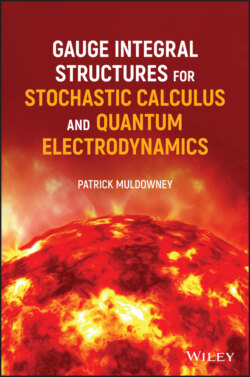Читать книгу Gauge Integral Structures for Stochastic Calculus and Quantum Electrodynamics - Patrick Muldowney - Страница 10
ОглавлениеReading this Book
The term “gauge” in the title relates to gauge integration in mathematics (a generalized form of Riemann integration). It is not about gauge symmetry or gauge transformations in theoretical physics.
The following abbreviations are used because of frequent references to these sources:
[F1] for [39], Space‐time approach to non‐relativistic quantum mechanics, by R.P. Feynman;
[FH] for [46], Quantum Mechanics and Path Integrals, by R.P. Feynman and A.R. Hibbs;
[MTRV] for [121], A Modern Theory of Random Variation, by P. Muldowney.
[ website ] for [122], https://sites.google.com/site/StieltjesComplete/ This is the website for this book, and for [MTRV].
References to chapters, sections, and figures in this book use a capital letter, “Chapter x”; but for material from other sources lower‐case is used: “figure y”.
This book develops themes in probability and quantum mechanics which were introduced in [MTRV]. The range of topics is smaller, and the range of notation is correspondingly smaller, with only a few new symbols. One such is the notation (denoting stochastic sum) on page below. Section 13.4 has a list of the main symbols used.
The subject of the predecessor book [MTRV] is the role of Cartesian product spaces , , in the theory of probability (including quantum mechanics), where is the set of real numbers, and is an interval of time.
The present book examines in more detail different kinds of Cartesian products of , as domains for integration of functions ,
Though the symbol will generally represent time, it is also used as an arbitrary finite or infinite set of labels , depending on the context.
The notation has two components: domain , and integrand . When is an infinite set, such as an interval of time, two different perspectives are present. These are the perspectives indicated in figures 3.1 and 3.2 on page 87 of [MTRV].
Figure 3.1 represents the graph of where is an argument of integrand . Figure 3.2 represents the domain whose elements are points, not graphs. Both of these perspectives should be kept in mind while using this book.
To see the significance of these alternate perspectives1, suppose and , so . In this case, for integrands which appear in this book, there may be little difference between the values of integrands in domain , and in if is continuous.
But domains and are very different; just as differs geometrically from , . The latter difference is the vehicle for the 19th century satire Flatland by Edwin A. Abbott [1], in which two‐dimensional beings struggle with the idea of a three‐dimensional universe.
The book can be read as a collection of standalone accounts of topics which are suggested, or introduced, or touched upon, in [MTRV]. Equally, it can be read as a supplement to [MTRV], developing the ideas of stochastic sums and path integrals which were introduced in [MTRV].
The formal theorem‐proof layout is avoided in favour of concrete illustrations. In almost cases, the relevant theorems and proofs are cited from [MTRV]. But exceptions are made for a few fundamental results such as analogues or versions of theorems 4, 62, 64, and 65 of [MTRV]. The theorem‐proof format is applied in these few exceptional cases.
Also, some of the illustrative examples are “thought experiments”, exercises of imagination intended to clarify, not finance or physics as such, but certain mathematical issues which arise in these subjects.
Notes and additional material for the book can be found at:
https://sites.google.com/site/StieltjesComplete/
—also used to record typos, errors, and corrections; and cited as [ website ] in this book.
Sincere thanks to colleagues and readers who help by sharing their thoughts via: stieltjes.complete.integral@gmail.com
Note
1 1 In [MTRV], usually denotes , with denoting . Also, is used in [MTRV] to denote , or .
